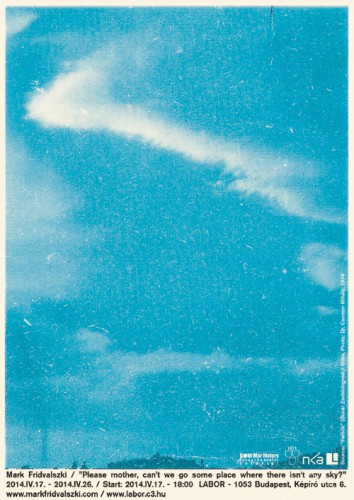| 2014. Apr. 17. | 18:00 |
Fridvalszki Márk / „Please mother, can‘t we go some place where there isn‘t any sky?“
(Albert E. Kahn: The Game of Death – Effects Of The Cold War On Our Children, 1953, 23.)
//////////////////////////////////////////////////////////////////////////////////////////////////////////////////////////////////////

//////////////////////////////////////////////////////////////////////////////////////////////////////////////////////////////////////
Opening: Thursday, April 17th, 2014, 6pm
7pm Zoltan Solomon LIVE
Labor: 1053 Budapest, Képíró u. 6.,
Bunker systems serve to protect and survive. Their memory bring to our mind the Cold War paranoia and it’s emblematic image: a trembling finger placed on a red button, ready to light the world on fire. The little American boy quoted in the exhibition’s title willingly asks his mother for a place unfriendly, claustrophobic and dark, that saves him from the uncanny buzzing approaching from the sky. Bunkers are described as prisons, crypts, graves, or at the very least asylum, as an ambivalent medium removing us from reality, space and time. For shorter or longer we are kept aloof from everything left on the surface.
Being 25 years after Transition, it became clear that neither decontamination equipment, nor residential air-raid shelters provide the necessary protection from mankind`s destructive force. Nevertheless, artists, theorists as well as tourists show recent interest for the manifold entity of these post-war structures. The bunker is approached not merely as an historical artifact but as a spatial metaphor for the current anxieties of controlled and directed societies.
Mark Fridvalszki’s space-specific and multimedia installation conjures the shelters built against WMDs (weapons of mass destruction), nostalgically reflecting upon the graphic, material and intellectual culture of the Cold War period. As its point of origin, this subject can be traced back to his earlier works, however it will gain a new formulation for the upcoming display at Labor Budapest. The artist breaks with the flat system of the panel and creates an environment filling the whole space. Latter is accomplished together with Zoltan Solomon’s sonic space-interpretation, a life-act, to be performed at the exhibition’s opening, adding a new dimension to the presentation and the intended bunker-atmosphere.
(Krisztina Hunya)
Exhibition on view until April 27th, 2014.
Opening hours:
///////////////////////////////////////////////////////////////////////////////////////////////////////////////////////////////////
Conversation in ENGLISH with Dr. Csaba Békés, founding director of the Cold War History Research Center Budapest, professor at the Corvinus University Budapest.
Friday, April 18th, 2014, 6 pm
The day after the opening, on April 18th Dr. Csaba Békés, founding director of the Cold War History Reseach Center will share with us the aims and achievements of the institute. What latest questions occupy researchers today when examining the Cold War Period? How does new information alter earlier misconceptions? And how does the media propaganda quoted in the exhibition relate to political reality? The center’s international interns will produce a research paper, each on their own country, about the constant fear of an atomic war and the practical as well as ideological functions of air-raid shelters, allowing a parallel view on history. While Mark Fridvalszki’s installation looks at past events from an emotional and artistic point of view, the Cold War History Research Center presents its scientific backgrounds.
Facebook: http://www.facebook.com/ColdwarHistoryResearchCenter
